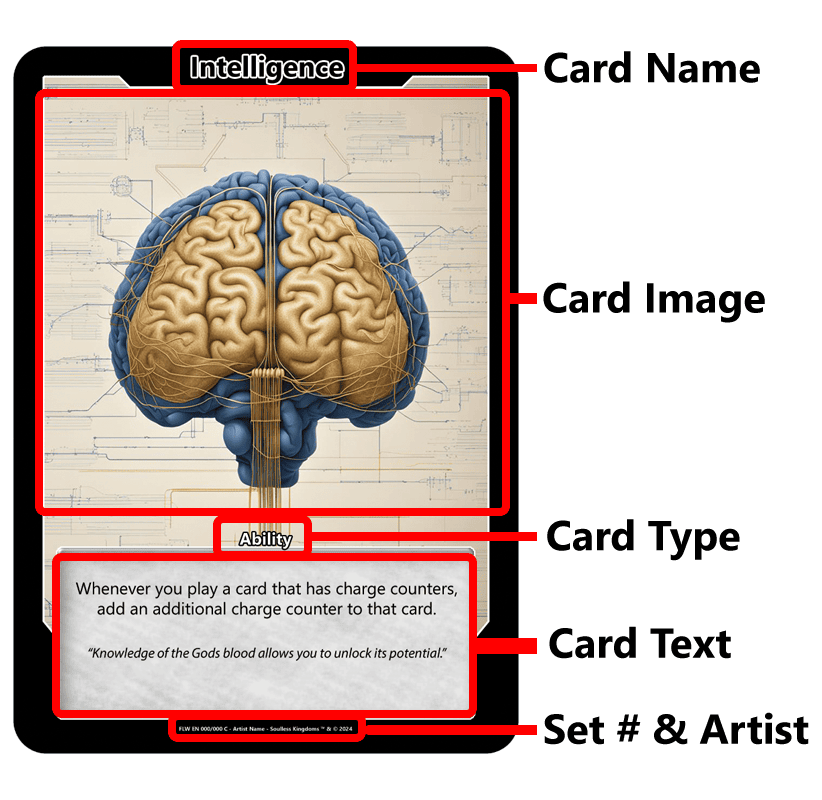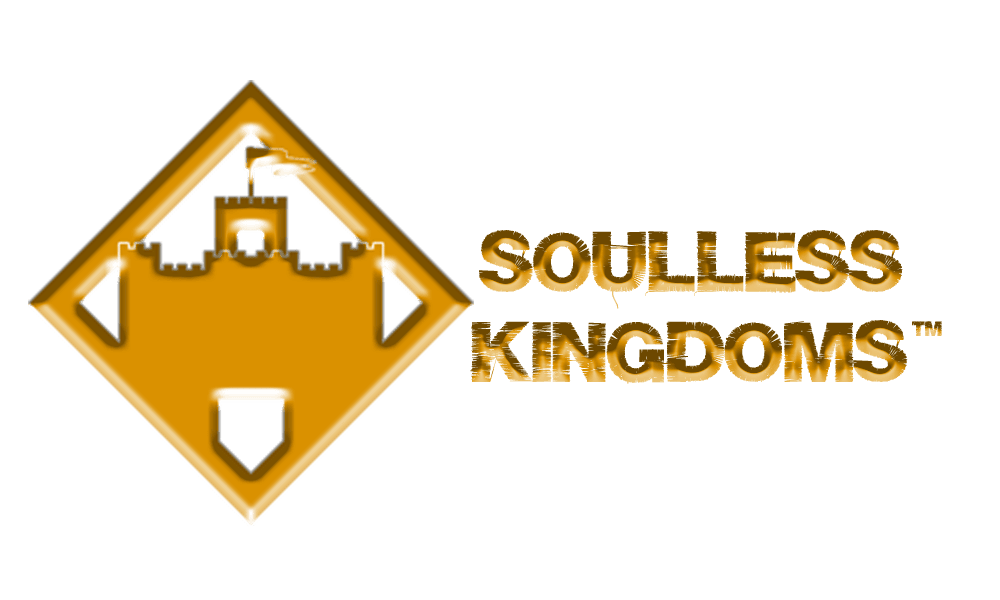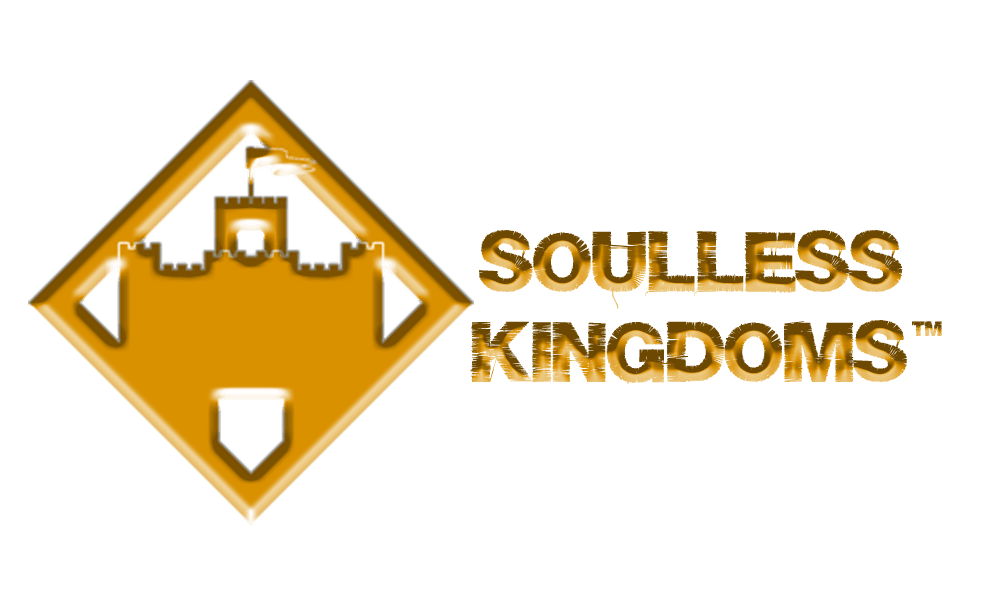How to Play Soulless Kingdoms™ TCG
Duel - Duels are the quickest, most cost efficient and most random way to enjoy the game. All you have to do is purchase a single booster pack and play. A Duel is limited to 2 players.
Step 1) Purchase a Soulless Kingdoms Booster Pack.
Step 2) Place all cards from the booster pack into your hand.
Step 3) Each player will set their HP (Hit Points) to 25
Step 4) Each player rolls a 10 sided die, highest roll gets to decides who goes first.
Battle - Battles are the longer form of gameplay. In battles every player will have a pre-constructed deck of 50 cards or more. A battle does not have a limit to players.Step 1) Each player will build a deck containing 50 or more cards.Step 2) Each player will shuffle their deck and place it on the field.Step 3) Each player will set their HP (Hit Points) to 50.Step 4) Each player will draw 9 cards.Step 5) Each player rolls a 10 sided die, highest roll decides who goes first.
War - Wars are the longest and largest form of gameplay. you will need at least 2 teams of at least 2 people on each team each with their own pre-constructed deck of at least 50 cards. There is no limit to how many teams play.Step 1) Each player will build a deck containing 50 or more cards.Step 2) Each player will shuffle their deck and place it on the field.Step 3) Each player will set their HP (Hit Points) to 50.Step 4) Each player will draw 9 cards.Step 5) Each player rolls a 10 sided die, Highest roll goes first, Second highest goes second, third highest goes third, etc. If there is a tie, those who tied will re-roll a 10 sided die to see who goes before the other. repeat until everyone has a turn order.
- You may only have 3 cards sharing the same name.
- You may only have 1 of each mastery card sharing the same name.
- You must have at least 50 cards in a deck.
- You can only have a maximum of 100 cards in a deck.
⦁Declare Combat - Any abilities that state '[Declare Combat]' will trigger here.⦁Declare Attacks - Declare which weapon or weapons you are attacking with. to do this you will activate your weapon card, to activate your weapon card you will turn it sideways. this signifies that the weapon is being used to attack. any abilities that state [On Attack] trigger here.⦁Declare Blocks - Your opponent will be able to declare whether they will block the attack or not. You may only block one attack with a shield card. To signify an attack is being blocked, you will turn the shield card sideways. any abilities that state [On Block] will trigger here.⦁Damage Step - Calculate the total damage a player will receive. Any damage that isn't block or reduced by armor will deal damage to a players hit points (HP). Any abilities that state [On Hit] will trigger here.
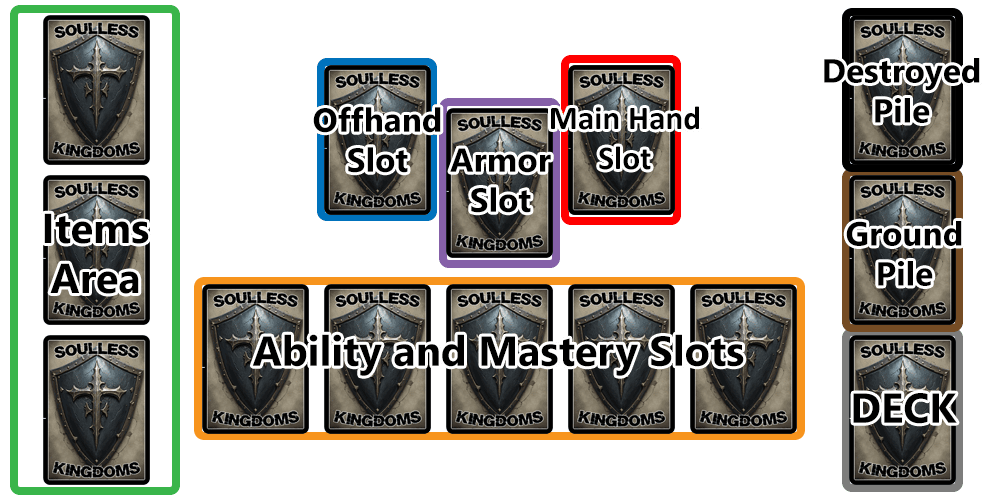
Deck is where you will place your pre-constructed deck of cards.
Ground Pile is your discard pile which is where cards that are 'dropped' will go.
Destroyed Pile is where any cards that are 'destroyed' will go.
Main Hand Slot is where you will place your weapon cards.
Armor Slot is where you will place your armor cards.
Offhand Slot is typically for your shield cards.
Ability and Mastery Slots is where you will put your ability and mastery cards.
Items Area is where you will put your item cards.
Your side of the play area is called the Field. You and your opponents play area is called the Battlefield.
ACTIONAction Cards can be played during your main phase and are put into the destroyed pile once used unless otherwise specified.ABILITYAbility Cards can be played during your main or secondary phase. They grant additional benefits to a player. A player can have up to a maximum of 5 ability or mastery cards on the field at one time. Ability cards remain on the field unless otherwise specified. If an ability or mastery is replaced it is placed into the ground pile.
ARMORArmor Cards can be played during your main or secondary phase. they grant a reduction to the total damage received by an attack. Armor Cards remain on the field unless otherwise specified. If an Armor is replaced it is placed into the ground pile. Armor Cards have 3 resistance types, bludgeoning, piercing and slashing which are located at the top right of the card. When hit by an attack you reduce the total damage of that attack by the number next to the resistance type.
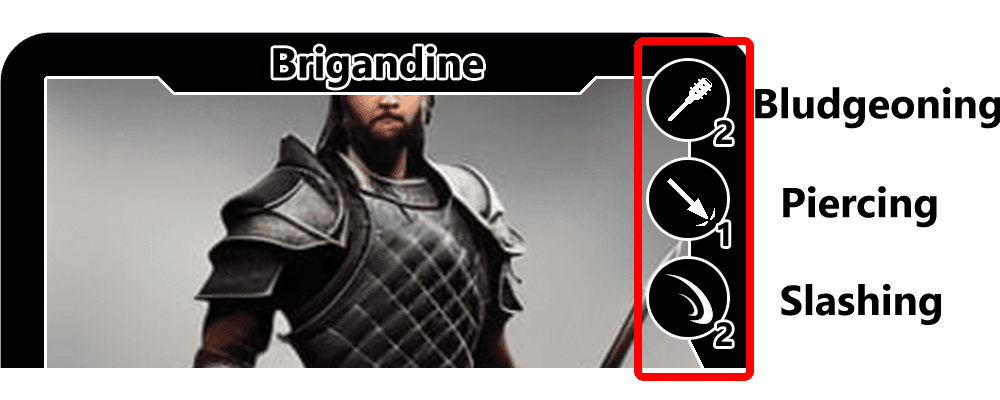
COUNTERCounter Cards can be played in response to an opponents card. Counter Cards are placed in the destroyed pile once used.ITEMItem Cards can be used during your main or secondary phase. A player can have any amount of item cards on the field at any given time. There are 2 types of Item Cards, Item and Consumable Items. Item cards remain on the field unless otherwise specified while consumable items are put into the destroyed pile once used, unless otherwise specified.MASTERYMastery Cards can be played during your main or secondary phase. A player can have up to a maximum of 5 ability and/or mastery cards on the field at one time. A players deck may only contain 1 mastery card with the same card name. Mastery cards remain on the field unless otherwise specified.SHIELDShield Cards can be played during your main or secondary phase. They are used to block an incoming attack and remain on the field unless otherwise specified. If they are replaced they are placed in the ground pile.Shield Cards have a block chance represented by an image of a shield with a number next to it located at the bottom right of the card. When you are attacked by a melee attack your opponent must roll a number higher than the block chance to hit you, otherwise all damage from the attack negated. You may only block one attack per round. Shields cannot block ranged attacks unless otherwise stated.
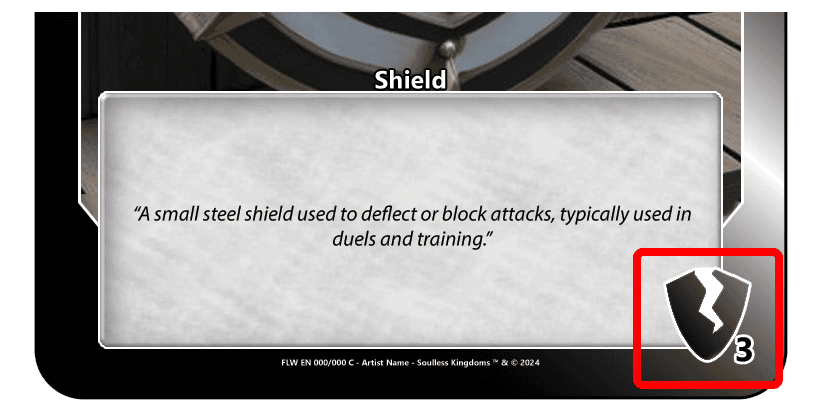
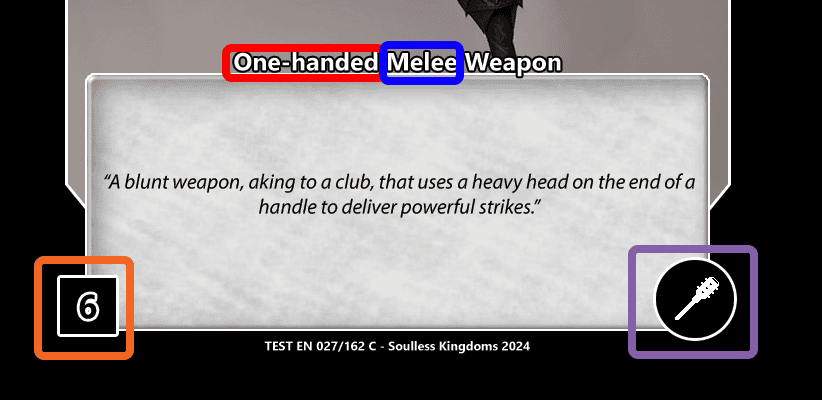
Weapon Cards also have damage dice and damage types. Damage Dice are displayed on the bottom left of a card and Damage Type is displayed on the bottom right of the card. An image at the bottom right of a card represents the 3 damage types which are as follows; Bludgeoning, Piercing, and Slashing. An image at the bottom left of a card represents the type of die to roll for your damage die, which are as follows: 4-sided, 6-sided, 8-sided, 10-sided, and 12-sided.
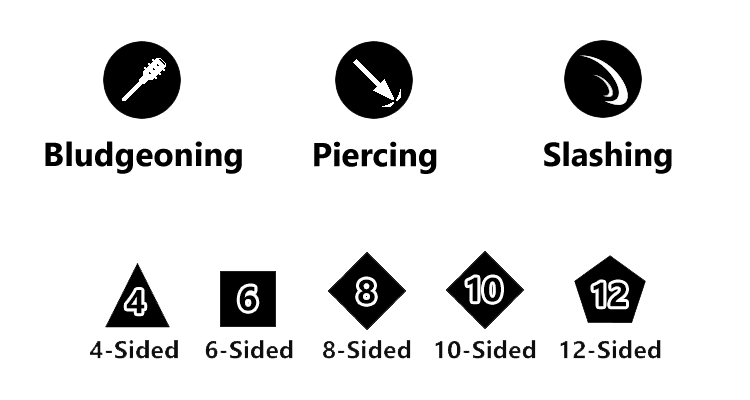
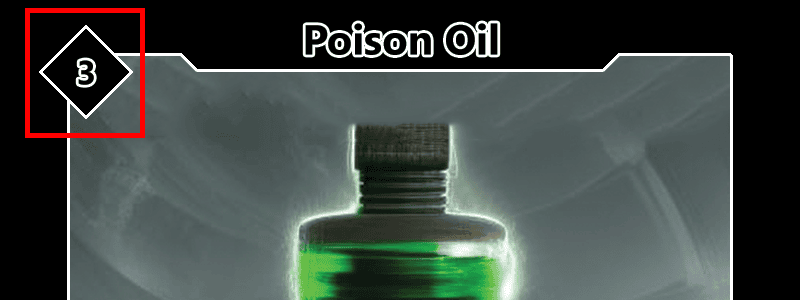
CHARGE COUNTERSCharge counters are counters on a card that are typically removed in order to use an ability or effect. Charge counters are represented as a symbol in the upper left hand corner of the card. You can use counters or dice to represent how many charge counters a card has.
BUFFSThere are many ways to increase the damage of your attack, defense of your armor, and block chance of your shields. This is through Buffs.To buff your cards you can play another weapon, armor or Shield card on top of one currently on the field. Just add the Dice, or number next to the block chance or defense. However, they can only buff if they completely match the card type. for example a one-handed melee weapon, cannot buff a two-handed melee weapon or a one-handed ranged weapon. Specifically for weapons the damage type must also match, a slashing weapon cannot buff a bludgeoning weapon. If you attack with a buffed weapon, block with a buffed shield, or are hit when wearing buffed armor, the top card will be destroyed, placing it into the destroyed pile.
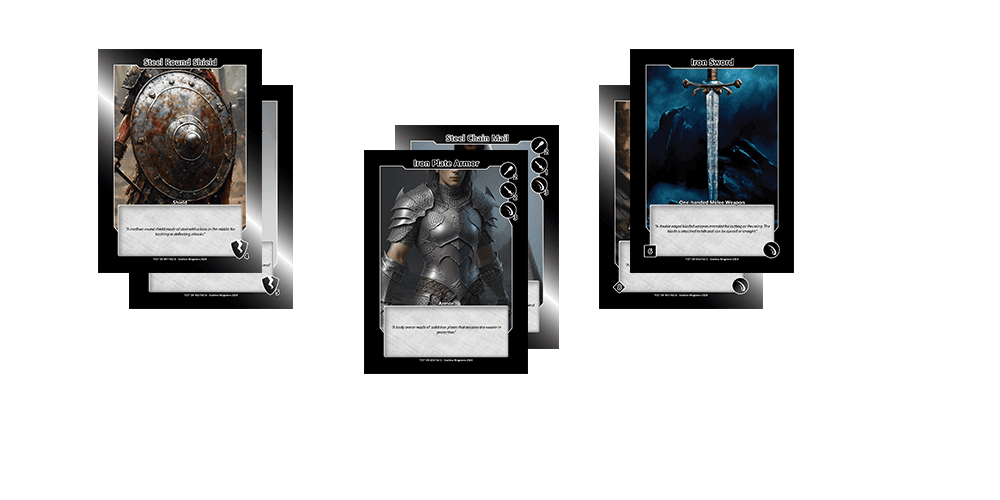
STATUS EFFECTSThere are 3 status effects. Fire, Frozen and Poison.Fire Status Effect: When a card effect states that a player has to make a fire status effect chance difficulty of # it means they must roll a 10 sided die. If they beat the number they do not receive the fire status effect. If they do not beat the number they are considered on fire for as many turns as they rolled. (example: Status Effect Chance Difficulty is a 5 and you roll a 3, then you are on fire for 3 turns). If a player must make another Fire Status Effect Chance roll, the turns they are on fire are accumulative up to 10 turns. At the start of their turn, a player that is on fire must roll a 4-sided die and take that rolls damage (this damage is not altered by armor).Frozen Status Effect: A card affected by the frozen condition cannot be used until it is no longer frozen. All effects and use of the card are negated until the end of that players turn.Poison Status Effect: A player affected by the poisoned condition takes damage equal to how many poison counters they have at the end of their turn. (this damage is not altered by armor).
TEXT DICE SYMBOLS
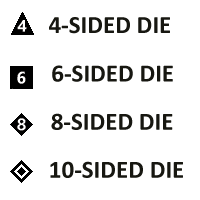
KEYWORDS
Keywords are a word or series of words that encompass what a card does. Here is a list of all the keywords currently in the TCG;
[Light Weapon] - a light weapon can be equipped in your off hand slot instead of your main hand. potentially allowing you to use 2 weapons.[Throwable] - a throwable weapon allows you to make a melee weapon become a ranged weapon at the cost of putting it into your ground pile.Equipment - equipment cards are all weapons, shields, armor and item cards.[x] - any number or x symbol in brackets, symbolizes the cost of charge counters needed to use an effect.Drop - a card that says to 'drop it' means to place it in the ground pile.Destroy - a card that says to 'destroy it' sends that card to the destroyed pile.
